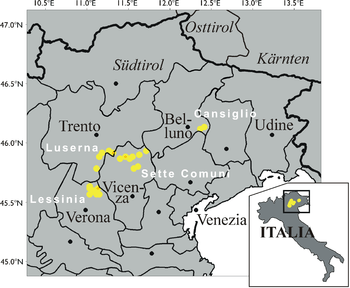Thirteen Communities

The Thirteen Communities (Cimbrian: Dreizehn Komoin, German: Dreizehn Gemeinden, Italian: Tredici Comuni) were a group of municipalities in the Veneto region that spoke the Cimbrian language, a dialect of Upper German, as their native tongue.
The municipalities are located on a high plateau northeast of Verona. They consist of:
- Vellje (German: Feld, Italian: Velo Veronese)
- (Rovereid, Roverè Veronese)
- (gen Wiesen, Erbezzo)
- Brunghe (Prugne, Selva di Progno), Ljetzan (Gletzen or Gliesen, Giazza) is a part of it
- Nuagankirchen (Neuenkirchen, Bosco Chiesanuova)
- Kalfàain, Màbado or Kam'Abato (Kalwein or Kalfein, Badia Calavena)
- Tschirre' or Sèr (Silva Hermanorum, Cerro Veronese),
- (Sankt Moritz, San Mauro di Saline)
- Asarin (Asarin, Azzarino), today a part of the municipality of Vellje
- Bòrtolom (San Bortolo or in the past San Bartolomeo tedesco), a part of Brunghe
- (Porrental, Val di Porro), a part of Nuagankirchen
- (Tavernole), today a part of San Mauro di Saline
- (Kampsilvan, Camposilvano), a part of Vellje
History
The thirteen communities formed together into a loose commonwealth around 1280. They were historically under the suzerainty of the Milanese House of Visconti and then under the Republic of Venice. Under both they enjoyed wide cultural and political autonomy in exchange for their loyalty. The autonomous status came to an end with the Napoleonic Wars and the demise of the Serenìsima in 1797.
Due to the high pressure from the Italianization from fascists such as Ettore Tolomei and the government of Benito Mussolini did the Cimbrian language eventually almost completely disappear and become extinct. Only in Ljetzan has Cimbrian partly survived.
Ljetzan has the cultural institute "Tautsche Püachar Haus" and ethnological museum which is a repository of the Cimbrian culture and cooperates with other linguistic enclaves in Luserna and the Seven Communities. Vestiges of the once dominant language can be found in some place names.
Example
The Cimbrian that was spoken in the Thirteen Communities was a slightly different dialect from Cimbrian spoken elsewhere.
| Cimbrian | German | English |
|---|---|---|
|
Vatar usar |
Vater unser |
Our Father |
References
- ↑ "Das Vaterunser auf Zimbrisch (13 Gemeinden)" (in Cimbrian). Frankfurter Allgemeine Zeitung. 2006. Retrieved 2011-05-13.
External links
- Gateway to the Land of the Cimbrians (German)
- Cimbrians of the Thirteen Communities in Ljetzan (Italian)
- Cultural Associations of the Cimbrians in Kulturverein der Zimbern im Cansiglio (German) (Italian)
- Sprachinselverein | Dreizehn Gemeinden (German)